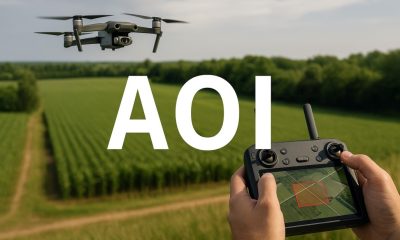U.S. Drone Regulations
Future Trends in U.S. Drone Regulations
Published
12 months agoon
Table Of Contents

Future Trends in U.S. Drone Regulations
The landscape of drone regulations is continuously evolving to keep pace with technological advancements, industry growth, and emerging use cases. Future trends in U.S. drone regulations are likely to focus on enhancing safety, integrating new technologies, and expanding operational capabilities. This section explores potential regulatory changes, technological advancements, and the perspectives of industry stakeholders.
Upcoming Regulatory Changes
Expansion of BVLOS Operations:
- The FAA is expected to expand Beyond Visual Line-of-Sight (BVLOS) operations to support a broader range of commercial applications, such as long-distance delivery and infrastructure inspections. Regulatory frameworks will likely include robust safety measures, such as detect-and-avoid systems and reliable communication links.
Integration with UTM Systems:
- Unmanned Aircraft System Traffic Management (UTM) systems are being developed to manage drone traffic in low-altitude airspace. The FAA is working with NASA and other stakeholders to implement UTM solutions that facilitate safe and efficient drone operations, particularly in urban environments.
Advanced Air Mobility (AAM):
- Regulations will likely evolve to accommodate Advanced Air Mobility (AAM) operations, including passenger-carrying drones (eVTOLs). The FAA is developing certification standards and operational guidelines to ensure the safe integration of AAM into the national airspace .
Night Operations and Flight Over People:
- The FAA is expected to further relax restrictions on night operations and flights over people, provided that drones are equipped with appropriate safety features such as anti-collision lights and parachute recovery systems. This will open up new opportunities for commercial and emergency response applications .
Technological Advancements Impacting Regulations
Detect-and-Avoid Systems:
- As detect-and-avoid technology advances, regulatory frameworks will likely incorporate requirements for these systems to enhance safety during BVLOS operations and in densely populated areas.
Remote ID and Tracking:
- The implementation of Remote ID will continue to evolve, with potential enhancements to tracking and identification systems to improve situational awareness and security. Future regulations may mandate more sophisticated Remote ID solutions for various classes of drones .
Autonomous Operations:
- The rise of autonomous drones will necessitate new regulations to address issues related to automated flight planning, decision-making, and safety protocols. The FAA is likely to develop guidelines for the certification and oversight of autonomous drone systems.
Industry and Advocacy Group Perspectives
Industry Advocacy:
- Industry groups such as the Association for Unmanned Vehicle Systems International (AUVSI) and the Small UAV Coalition are actively advocating for more flexible and supportive regulatory environments to foster innovation and commercial growth. They emphasize the importance of clear and consistent regulations to support investment and development.
Public Safety and Privacy Concerns:
- Advocacy groups focused on public safety and privacy are calling for regulations that address the potential risks associated with widespread drone use. This includes ensuring robust privacy protections, enforcing safety standards, and implementing measures to prevent misuse .
Global Harmonization:
- As the drone industry becomes more global, there is a push for harmonizing regulations across countries to facilitate international operations and standardize safety practices. The FAA is likely to collaborate with international aviation authorities to align U.S. regulations with global standards.
Future Challenges and Opportunities
Balancing Innovation and Safety:
- One of the key challenges for regulators will be balancing the need for safety with the desire to promote innovation and commercial growth. This will require adaptive regulatory frameworks that can evolve with technological advancements.
Infrastructure Development:
- The development of infrastructure to support widespread drone operations, such as vertiports for AAM and UTM systems, will be crucial. Regulations will need to address the integration of these infrastructures into existing urban landscapes and airspace management systems.
Public Acceptance and Trust:
- Building public acceptance and trust in drone technology will be essential for its widespread adoption. Transparent regulatory processes, effective communication of safety measures, and engagement with communities will play a vital role in achieving this.
Conclusion
The future of U.S. drone regulations will be shaped by ongoing technological advancements, industry needs, and public safety considerations. By staying informed about these trends and actively participating in the regulatory process, drone operators and stakeholders can help ensure a safe, innovative, and thriving drone ecosystem.
Frequently Asked Questions About Future Regulations for Drones in the U.S.
1. How will future drone regulations address privacy concerns?
Future drone regulations are expected to place a greater emphasis on privacy protections as drone usage becomes more widespread. This may include stricter rules on data collection and storage, requirements for obtaining consent before capturing images or videos, and enhanced transparency about how drone data is used. The FAA and other regulatory bodies might collaborate with privacy advocacy groups to develop comprehensive guidelines that balance innovation with privacy rights.
2. What advancements in drone technology are likely to influence future regulations?
Advancements in drone technology, such as improved autonomous navigation, enhanced collision avoidance systems, and more reliable communication links, are likely to influence future regulations. These technological improvements could lead to more relaxed restrictions on operations like Beyond Visual Line of Sight (BVLOS) and flights over people, provided that drones can demonstrate safe and reliable performance. Regulations will likely evolve to incorporate these advancements while maintaining rigorous safety standards.
3. How will urban air mobility (UAM) impact future drone regulations?
Urban Air Mobility (UAM), including the use of passenger drones and air taxis, is set to revolutionize transportation in urban areas. Future drone regulations will need to address the integration of UAM into existing air traffic management systems, establish safety and certification standards for new types of aircraft, and develop infrastructure such as vertiports. These regulations will aim to ensure the safe and efficient operation of UAM while minimizing disruption to current airspace users and urban environments.
To Learn more about acronyms used in this article visit our Drones Acronym Page.











